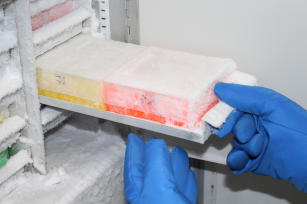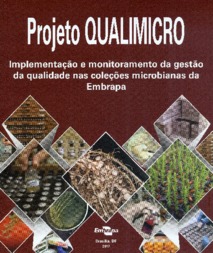Conservation of microbial genetic resources: objetctive is to guarantee the quality of the collections of Embrapa for the benefit of Brazilian agribusiness
Conservation of microbial genetic resources: objetctive is to guarantee the quality of the collections of Embrapa for the benefit of Brazilian agribusiness

Photo: LA FALCE, Marcos
Embrapa invests in the conservation of native strains of microorganisms, which can be used by the scientific community in several research programs, ranging from diagnosis, treatment of diseases and production of vaccines for human and animal application to reducing the environmental impact of Productive processes and the generation of renewable energy. In this perspective, microbial cultures are being continuously studied for the formation of a database of "active" components and their respective biological activities, in order to transform this microbial collection into more exploited resources.
For example, the use of nitrogen fixers, insecticides, fungicides and biological herbicides, bioremediation and plant growth promoters produced by microorganisms are tools that can meet the demands for higher yields of agricultural crops, at the same time reducing the release of products Chemicals in the environment.
The proper conservation of these microorganisms is what will guarantee this genetic material for application studies in agribusiness and related productive sectors.
The collections of microorganisms maintain species with potential for the biological control of pests, diseases and insects vectors of diseases; Multifunctional; Phytopathogenic diseases capable of causing diseases in different cultures of economic importance and that, therefore, can be used in programs of genetic improvement of plants for selection of resistant varieties; And of interest to agroindustry and animal production.
The microbial aspect of the Embrapa Genetic Resources Portfolio aims to ensure the adequate management of its microbial collection, taking into account the demands of raw material and inputs for agriculture and environmental preservation. For this, it covers the following actions:
- Collect, identify and conserve long-term microorganisms biological control agents at the Center for Biological Resources (CRB-ACB) of Embrapa Genetic Resources and Biotechnology
- Implement and monitor quality systems in the three categories of Embrapa microorganism collections (Biological Resource Centers, Institutional Collections and Work Collections), based on the corporate management model developed under the GESTCOL project
- Collect, identify and conserve diazotrophic bacteria and other multifunctional microorganisms at the Johanna Dobereiner Biological Resource Center (CRB-JD) of Embrapa Agrobiology
- Collect, identify and conserve diazotrophic bacteria and plant growth promoters at the Center of Biological Resources in Embrapa Soy Multifunctional Microorganisms (CRB-MM)
- Collect, identify and conserve multifunctional microorganisms of agricultural and environmental importance at the Center for Biological Resources in Multifunctional Microorganisms of Agricultural and Environmental Importance (CRB-MMIA) of Embrapa Meio Ambiente
- Collect, identify and conserve microorganisms in Institutional Collections of Embrapa
- Perform actions of exchange and quarantine of microorganisms
- Organize and computerize microbial genetic resources in the AleloMicro system
- Consolidate the system of curation of microorganisms and promote their interaction with curators and units holding microbial collections
For example, the use of nitrogen fixers, insecticides, fungicides and biological herbicides, bioremediation and plant growth promoters produced by microorganisms are tools that can meet the demands for higher yields of agricultural crops, at the same time reducing the release of products Chemicals in the environment.
The proper conservation of these microorganisms is what will guarantee this genetic material for application studies in agribusiness and related productive sectors.
The collections of microorganisms maintain species with potential for the biological control of pests, diseases and insects vectors of diseases; Multifunctional; Phytopathogenic diseases capable of causing diseases in different cultures of economic importance and that, therefore, can be used in programs of genetic improvement of plants for selection of resistant varieties; And of interest to agroindustry and animal production.
The microbial aspect of the Embrapa Genetic Resources Portfolio aims to ensure the adequate management of its microbial collection, taking into account the demands of raw material and inputs for agriculture and environmental preservation. For this, it covers the following actions:
- Collect, identify and conserve long-term microorganisms biological control agents at the Center for Biological Resources (CRB-ACB) of Embrapa Genetic Resources and Biotechnology
- Implement and monitor quality systems in the three categories of Embrapa microorganism collections (Biological Resource Centers, Institutional Collections and Work Collections), based on the corporate management model developed under the GESTCOL project
- Collect, identify and conserve diazotrophic bacteria and other multifunctional microorganisms at the Johanna Dobereiner Biological Resource Center (CRB-JD) of Embrapa Agrobiology
- Collect, identify and conserve diazotrophic bacteria and plant growth promoters at the Center of Biological Resources in Embrapa Soy Multifunctional Microorganisms (CRB-MM)
- Collect, identify and conserve multifunctional microorganisms of agricultural and environmental importance at the Center for Biological Resources in Multifunctional Microorganisms of Agricultural and Environmental Importance (CRB-MMIA) of Embrapa Meio Ambiente
- Collect, identify and conserve microorganisms in Institutional Collections of Embrapa
- Perform actions of exchange and quarantine of microorganisms
- Organize and computerize microbial genetic resources in the AleloMicro system
- Consolidate the system of curation of microorganisms and promote their interaction with curators and units holding microbial collections
Status: Completed Start date: Fri Jan 01 00:00:00 GMT-03:00 2016 Conclusion date: Thu Dec 31 00:00:00 GMT-03:00 2020
Head Unit: Embrapa Genetic Resources & Biotechnology
Project leader: Sueli Correa Marques de Mello
Contact: sueli.mello@embrapa.br

